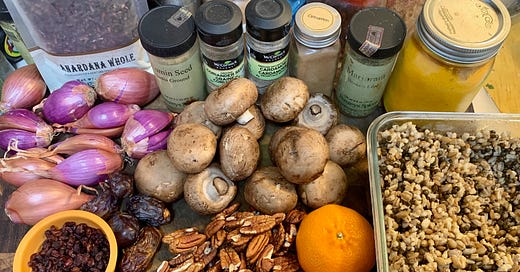The inspiration for Moon Grain came from a passage in a fantasy novel by Elizabeth Moon, The Sheepfarmer’s Daughter, the first novel in Moon’s Paksennarion series.
Then Arcolin announced a feast for them at The White Dragon. This was no ordinary dinner; though they came unwillingly, the splendor Arcolin had ordered had its effect. The table was loaded with roast stuffed fowl, a great crown roast with candied fruit for jewels on the crown, roast suckling pig in a nest of mushrooms, a pastry construction of the city of Rotengre, with little figures assaulting the walls and gate, and colored sugar flames rising from the roofs. Dishes Paks had never seen before: steamed grain with bits of mushroom, nuts, and spices in it, vegetables stuffed with cheese or meat or another vegetable or nuts. Thick soups and thin soups, sliced cheeses in every shade from white to deep orange, sweet cakes and pies of every kind. They ate until they were full, and overfull, washing it down with their choice of wines and ales. Paks drank more than she ever had, and felt, for the first time since seeing Siniava’s army come out of the trees, truly relaxed.
“Steamed grain with bits of mushroom, nuts, and spices in it” — that sounded good. I started by making a list of what I might use. For the grain, I thought of BROL, a recipe by Michael Greger: 1 cup each of hulled barley, rye berries, and oat groats (all intact whole grains), measured and then cooked. I use a grain cooker, but one can also mix the 3 cups of grain with 6 cups of water and simmer them in a covered pot until all the water’s been absorbed.
Once the grains are done, mix them with cooked beluga black lentils (1 cup, measured before cooking). For a gluten-free alternative, use SMOL instead (see below).
Make a batch of BROL and set that aside. Measure the spices into a bowl so they will be ready:
• 1 tablespoon dried marjoram
• 1 teaspoon ground cardamon
• 1 teaspoon ground cinnamon
• 1 teaspoon ground coriander
• 2 teaspoons ground cumin
• 2 teaspoons ground turmeric
• 1 tablespoon ground black pepper
Then put the following into a 6-qt pot:
• 3 tablespoons EVOO
• about 8 shallots, chopped
• 1 teaspoon salt
• 1/2 teaspoon MSG (it’s okay)
One shallot will often split into two pieces, so a count is not so useful. After the shallots are trimmed and peeled, before chopping, use about 2 cups; chopped small, that will be about 1 cup or a little more.
Cook the shallots over medium heat until they are transparent and just starting to brown, then add:
• 24 medium crimini or white mushrooms quartered
• 2 cups pecan halves
Cook, stirring, until the mushrooms give up their water, about ten minutes.
The mushrooms are quartered rather than sliced because I wanted large pieces. You could also use shiitake mushrooms (more expensive). For those, I would cut the caps in half.
Add the spices, stir to mix, and cook briefly. The spices tend to stick, so add a small splash of water (or wine) to release them. Then add:
• 4-5 cups of the BROL
• 1/2 cup dried barberries (found online or at Mid-Eastern delis)
• 1/2 cup pomegranate seeds (“anardana” in photo)
• 6 Medjool dates, pitted and chopped
Bring that to cooking temperature over medium or medium-low heat, stirring frequently with a spatula so you can ensure that it doesn’t stick to the bottom of the pan. Once it is hot and at cooking temperature, stir in:
• the pulp of 2 large seedless lemons, peeled and then blended
• separated segments from 3 large seedless tangerines (2 in photo, but use 3)
This is a whole-food plant-based dish, one that’s especially high in antioxidants — thanks in particular to the cinnamon, marjoram, turmeric, barberries, and pomegranate seeds. (For more information, see this video — and while you’re at it, this one too. I did consider including ground cloves, but I feared that flavor would dominate.)
It’s hearty fare (the feast in the novel was for a contingent of soldiers). The spices give it some kick and the fruit sweetens it and makes it more festive. I will be making this for Thanksgiving.
SMOL, a gluten-free alternative to BROL
For those who are gluten-intolerant, use SMOL instead of BROL: Sorghum, millet, oat groats, and lentils.
The best sorghum is black sorghum and the second-best is red, but those seem impossible to find. However, whole-grain white sorghum is relatively easy to find.
Millets are excellent — I particularly like Kodo millet and barnyard millet. Intact whole-grain millets (unpolished millets) are readily available online.
An upgrade: Use purple barley, sprouted grains, and sprouted lentils
The next time I make this, I’ll use purple barley, much higher in antioxidants than regular hulled barley (US source; Canadian source).
I’ll also use sprouted rye, sprouted oats, and sprouted lentils. Sprouted seeds (grains, lentils, and the like) have benefits — as described by Harvard Medical School:
Sprouted grains have many health benefits. It’s the result of catching the sprouts during the germinating process. “This germinating process breaks down some of the starch, which makes the percentage of nutrients higher. It also breaks down phytate, a form of phytic acid that normally decreases absorption of vitamins and minerals in the body. So sprouted grains have more available nutrients than mature grains,” Secinaro says. Those nutrients include folate, iron, vitamin C, zinc, magnesium, and protein. Sprouted grains also may have less starch and be easier to digest than regular grains.




Sounds wonderful. I'll take an order, depending on shipping costs to US.